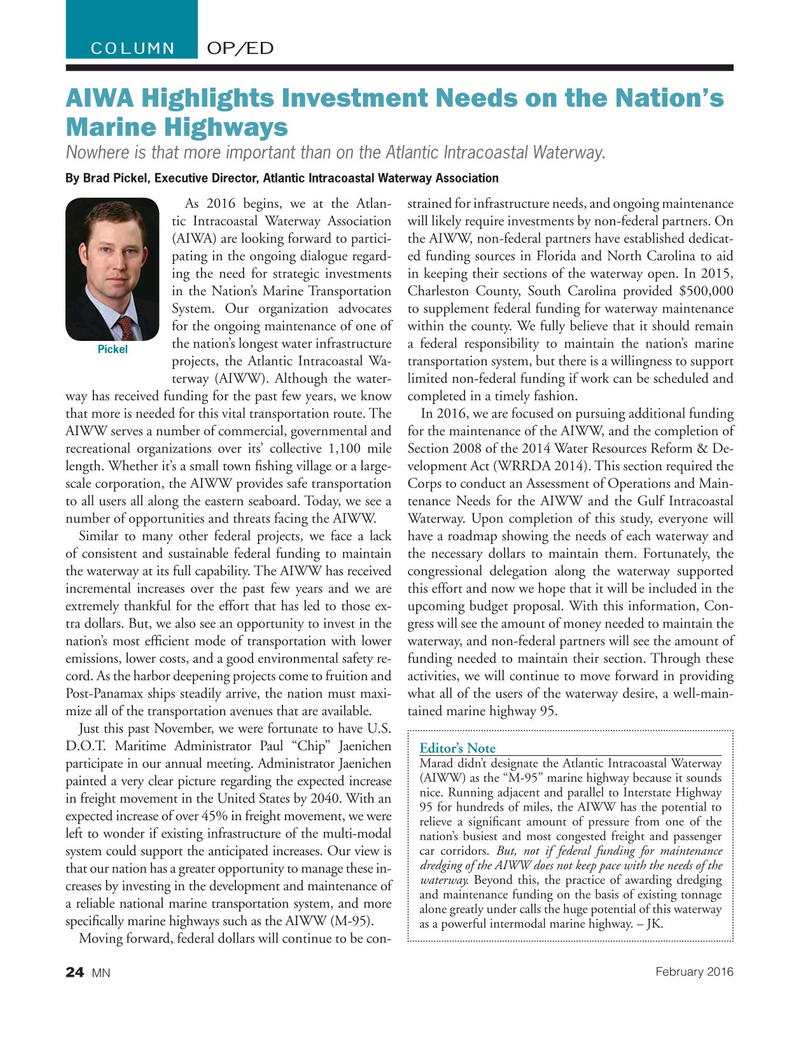
Page 24: of Marine News Magazine (February 2016)
Dredging & Marine Construction
Read this page in Pdf, Flash or Html5 edition of February 2016 Marine News Magazine
COLUMN OP/ED
AIWA Highlights Investment Needs on the Nation’s
Marine Highways
Nowhere is that more important than on the Atlantic Intracoastal Waterway.
By Brad Pickel, Executive Director, Atlantic Intracoastal Waterway Association
As 2016 begins, we at the Atlan- strained for infrastructure needs, and ongoing maintenance tic Intracoastal Waterway Association will likely require investments by non-federal partners. On (AIWA) are looking forward to partici- the AIWW, non-federal partners have established dedicat- pating in the ongoing dialogue regard- ed funding sources in Florida and North Carolina to aid ing the need for strategic investments in keeping their sections of the waterway open. In 2015, in the Nation’s Marine Transportation Charleston County, South Carolina provided $500,000
System. Our organization advocates to supplement federal funding for waterway maintenance for the ongoing maintenance of one of within the county. We fully believe that it should remain the nation’s longest water infrastructure a federal responsibility to maintain the nation’s marine
Pickel projects, the Atlantic Intracoastal Wa- transportation system, but there is a willingness to support terway (AIWW). Although the water- limited non-federal funding if work can be scheduled and way has received funding for the past few years, we know completed in a timely fashion. that more is needed for this vital transportation route. The In 2016, we are focused on pursuing additional funding
AIWW serves a number of commercial, governmental and for the maintenance of the AIWW, and the completion of recreational organizations over its’ collective 1,100 mile Section 2008 of the 2014 Water Resources Reform & De- length. Whether it’s a small town ? shing village or a large- velopment Act (WRRDA 2014). This section required the scale corporation, the AIWW provides safe transportation Corps to conduct an Assessment of Operations and Main- to all users all along the eastern seaboard. Today, we see a tenance Needs for the AIWW and the Gulf Intracoastal number of opportunities and threats facing the AIWW. Waterway. Upon completion of this study, everyone will
Similar to many other federal projects, we face a lack have a roadmap showing the needs of each waterway and of consistent and sustainable federal funding to maintain the necessary dollars to maintain them. Fortunately, the the waterway at its full capability. The AIWW has received congressional delegation along the waterway supported incremental increases over the past few years and we are this effort and now we hope that it will be included in the extremely thankful for the effort that has led to those ex- upcoming budget proposal. With this information, Con- tra dollars. But, we also see an opportunity to invest in the gress will see the amount of money needed to maintain the nation’s most ef? cient mode of transportation with lower waterway, and non-federal partners will see the amount of emissions, lower costs, and a good environmental safety re- funding needed to maintain their section. Through these cord. As the harbor deepening projects come to fruition and activities, we will continue to move forward in providing
Post-Panamax ships steadily arrive, the nation must maxi- what all of the users of the waterway desire, a well-main- mize all of the transportation avenues that are available. tained marine highway 95.
Just this past November, we were fortunate to have U.S.
D.O.T. Maritime Administrator Paul “Chip” Jaenichen
Editor’s Note
Marad didn’t designate the Atlantic Intracoastal Waterway participate in our annual meeting. Administrator Jaenichen (AIWW) as the “M-95” marine highway because it sounds painted a very clear picture regarding the expected increase nice. Running adjacent and parallel to Interstate Highway in freight movement in the United States by 2040. With an 95 for hundreds of miles, the AIWW has the potential to expected increase of over 45% in freight movement, we were relieve a signi? cant amount of pressure from one of the left to wonder if existing infrastructure of the multi-modal nation’s busiest and most congested freight and passenger car corridors. But, not if federal funding for maintenance system could support the anticipated increases. Our view is dredging of the AIWW does not keep pace with the needs of the that our nation has a greater opportunity to manage these in- waterway. Beyond this, the practice of awarding dredging creases by investing in the development and maintenance of and maintenance funding on the basis of existing tonnage a reliable national marine transportation system, and more alone greatly under calls the huge potential of this waterway speci? cally marine highways such as the AIWW (M-95).
as a powerful intermodal marine highway. – JK.
Moving forward, federal dollars will continue to be con-
February 2016
MN 24
MN Feb16 Layout 18-31.indd 24 1/21/2016 11:30:44 AM

 23
23

 25
25
